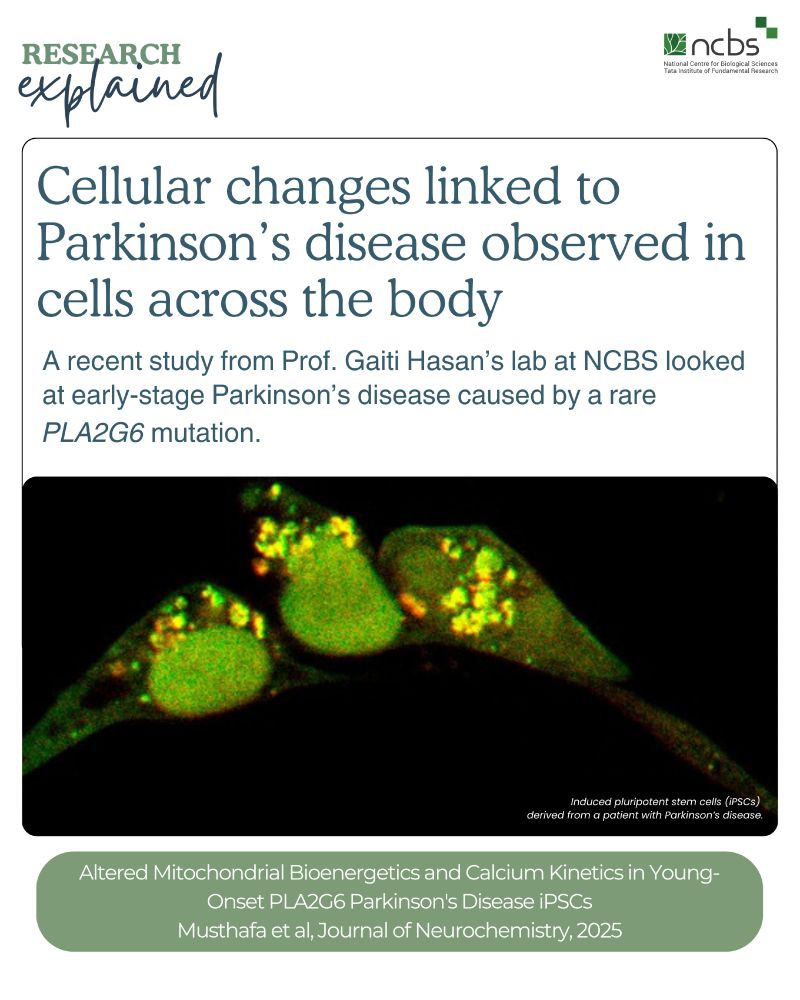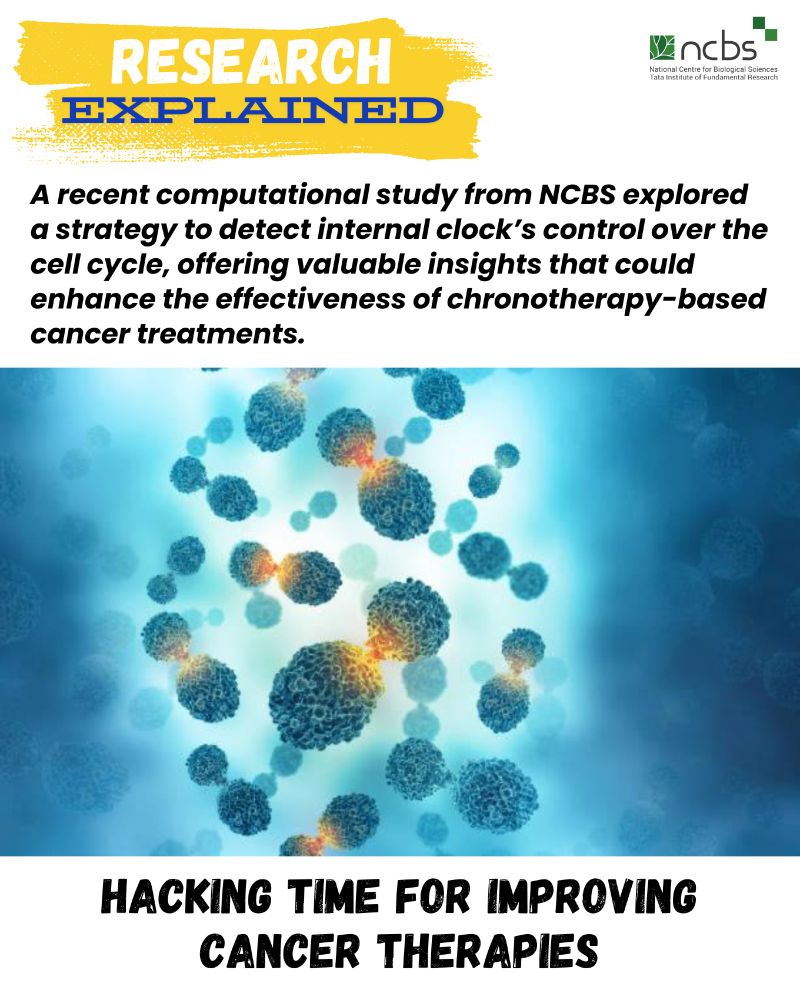Using BEST-HSQC NMR, Dr Rashmi Agrata from Dr Ranabir Das's team at NCBS team tracked ubiquitin deamidation in real-time, revealing varied deamidase efficiencies despite similar structures.
Read here: bit.ly/3L56RIR
✏️Christeen Paulson

Using BEST-HSQC NMR, Dr Rashmi Agrata from Dr Ranabir Das's team at NCBS team tracked ubiquitin deamidation in real-time, revealing varied deamidase efficiencies despite similar structures.
Read here: bit.ly/3L56RIR
✏️Christeen Paulson
⚡ Quantum chemistry is no longer theoretical — it’s the blueprint for future quantum tech.
#QuantumTech #Spintronics #MolecularWires #QuantumChemistry #ResearchExplained #OxfordScience #ScienceCommunication


⚡ Quantum chemistry is no longer theoretical — it’s the blueprint for future quantum tech.
#QuantumTech #Spintronics #MolecularWires #QuantumChemistry #ResearchExplained #OxfordScience #ScienceCommunication
A recent study investigated how large herbivores use old village sites in Satpura Tiger Reserve, Madhya Pradesh, after these places were turned into grasslands following relocation.🦌🌲🛖
🔗Read Here bit.ly/3IsCbjR
✏️ Christeen Paulson
@ncbsbangalore.bsky.social

A recent study investigated how large herbivores use old village sites in Satpura Tiger Reserve, Madhya Pradesh, after these places were turned into grasslands following relocation.🦌🌲🛖
🔗Read Here bit.ly/3IsCbjR
✏️ Christeen Paulson
@ncbsbangalore.bsky.social
Why do some animals deter predators using striking visual displays, while others rely on camouflage?
Read here: bit.ly/4nYtVXS
✏️ Dr Krushnamegh Kunte

Why do some animals deter predators using striking visual displays, while others rely on camouflage?
Read here: bit.ly/4nYtVXS
✏️ Dr Krushnamegh Kunte
With ecosystems shifting faster than ever due to climate change, habitat loss & human activity, scientists are asking a crucial question: how do species survive in new hostile environments, & what makes some succeed while others fail?
Read: bit.ly/3V2O4Qb
@deepaagashe.bsky.social

With ecosystems shifting faster than ever due to climate change, habitat loss & human activity, scientists are asking a crucial question: how do species survive in new hostile environments, & what makes some succeed while others fail?
Read: bit.ly/3V2O4Qb
@deepaagashe.bsky.social
During embryo development, if cells fail to arrange or align correctly, organs could fail to function properly. Yet, cells somehow manage to find their place & align with remarkable precision.
Read here: bit.ly/46gbk2j
✏️Christeen Paulson

During embryo development, if cells fail to arrange or align correctly, organs could fail to function properly. Yet, cells somehow manage to find their place & align with remarkable precision.
Read here: bit.ly/46gbk2j
✏️Christeen Paulson
Without 3D structural data, how can we uncover the functions of the vast majority of proteins?
Read here: bit.ly/4mEzJpg
✏️ @mrunalnk.bsky.social

Without 3D structural data, how can we uncover the functions of the vast majority of proteins?
Read here: bit.ly/4mEzJpg
✏️ @mrunalnk.bsky.social
In the animal kingdom, social hierarchies are everywhere. Being at the top often comes with perks: better access to food, mates, & a territory. But could it also offer protection from life’s psychological blows?
Read here: bit.ly/44Qw1lS
✏️Christeen Paulson

In the animal kingdom, social hierarchies are everywhere. Being at the top often comes with perks: better access to food, mates, & a territory. But could it also offer protection from life’s psychological blows?
Read here: bit.ly/44Qw1lS
✏️Christeen Paulson
A recent study from Prof. @rpadinjat.bsky.social and Prof R. Sowdhamini's lab found that genes encoding PIP4K—a key enzyme in the phosphoinositide signalling pathway that regulates PIP3 levels—are found exclusively in metazoans.
Read: bit.ly/3TIyxo0
✏️@rupsykhurana.bsky.social

A recent study from Prof. @rpadinjat.bsky.social and Prof R. Sowdhamini's lab found that genes encoding PIP4K—a key enzyme in the phosphoinositide signalling pathway that regulates PIP3 levels—are found exclusively in metazoans.
Read: bit.ly/3TIyxo0
✏️@rupsykhurana.bsky.social
🐕Free-ranging dogs are changing Spiti Valley's fragile food web, forcing red foxes to adapt.
🦊NCBS MSc. Wildlife program alumnus Herman Ramesh & team investigated how varying dog densities influence red fox behaviour.
Read here: bit.ly/3IukakD
✏️ @rupsykhurana.bsky.social

🐕Free-ranging dogs are changing Spiti Valley's fragile food web, forcing red foxes to adapt.
🦊NCBS MSc. Wildlife program alumnus Herman Ramesh & team investigated how varying dog densities influence red fox behaviour.
Read here: bit.ly/3IukakD
✏️ @rupsykhurana.bsky.social
A recent study from Prof. Gaiti Hasan's lab at NCBS investigated PLA2G6-associated Parkinson’s disease using patient-derived iPSC's.
Read Here: bit.ly/3GtTD6v
@thasneemmusthafa.bsky.social @ncbsbangalore.bsky.social
✏️ @mrunalnk.bsky.social

A recent study from Prof. Gaiti Hasan's lab at NCBS investigated PLA2G6-associated Parkinson’s disease using patient-derived iPSC's.
Read Here: bit.ly/3GtTD6v
@thasneemmusthafa.bsky.social @ncbsbangalore.bsky.social
✏️ @mrunalnk.bsky.social
Latest study from @stpalli.bsky.social's lab highlights a potential biophysical mechanism that could have enabled early multicellular clusters to grow larger & more complex before specialised transport systems evolved.
Read here: bit.ly/3G8i6xQ
✏️ @rupsykhurana.bsky.social

Latest study from @stpalli.bsky.social's lab highlights a potential biophysical mechanism that could have enabled early multicellular clusters to grow larger & more complex before specialised transport systems evolved.
Read here: bit.ly/3G8i6xQ
✏️ @rupsykhurana.bsky.social
In a first, @vivekharisundar.bsky.social & team from Dr @shivaprasadpv.bsky.social 's group has identified a new H4 histone variant in rice which may have helped semi-aquatic rice varieties adapt to changing environments.🌾
Read here: bit.ly/4jNcirp
By @rupsykhurana.bsky.social

In a first, @vivekharisundar.bsky.social & team from Dr @shivaprasadpv.bsky.social 's group has identified a new H4 histone variant in rice which may have helped semi-aquatic rice varieties adapt to changing environments.🌾
Read here: bit.ly/4jNcirp
By @rupsykhurana.bsky.social
Riddhi Deshmukh & team from Dr Krushnamegh Kunte's lab examined butterfly populations in Southeast Asia to reveal how species split and evolve when their populations become geographically separated.🦋
Read here: bit.ly/3SHBNzq
✏️ Christeen Paulson

Riddhi Deshmukh & team from Dr Krushnamegh Kunte's lab examined butterfly populations in Southeast Asia to reveal how species split and evolve when their populations become geographically separated.🦋
Read here: bit.ly/3SHBNzq
✏️ Christeen Paulson
Himanshu C. & team from Prof Uma Ramakrishnan's group is using trace DNA at livestock kill sites to help ID the exact predator- species & individual, paving the way for more informed & strategic conservation resolutions
Read here: bit.ly/4k1HKmL
✏️ @rupsykhurana.bsky.social

Himanshu C. & team from Prof Uma Ramakrishnan's group is using trace DNA at livestock kill sites to help ID the exact predator- species & individual, paving the way for more informed & strategic conservation resolutions
Read here: bit.ly/4k1HKmL
✏️ @rupsykhurana.bsky.social
@shaonchakrabarti.bsky.social's lab at NCBS explored a new strategy to detect the internal clock’s control over the cell cycle, offering valuable insights that could enhance the effectiveness of chronotherapy-based cancer treatments.
Read Here: bit.ly/42X82Ax
✏️ Christeen Paulson

@shaonchakrabarti.bsky.social's lab at NCBS explored a new strategy to detect the internal clock’s control over the cell cycle, offering valuable insights that could enhance the effectiveness of chronotherapy-based cancer treatments.
Read Here: bit.ly/42X82Ax
✏️ Christeen Paulson
Dr Meghna Krishnadas' lab studied how plants fine-tune their strategies to survive & reproduce in challenging environments, like the higher reaches of the Himalayas, where temperatures rarely go beyond 15°C.
Read here: bit.ly/3RGXZZY
✏️Christeen Paulson

Dr Meghna Krishnadas' lab studied how plants fine-tune their strategies to survive & reproduce in challenging environments, like the higher reaches of the Himalayas, where temperatures rarely go beyond 15°C.
Read here: bit.ly/3RGXZZY
✏️Christeen Paulson
A latest study from Prof Raghu Padinjat's lab at NCBS has proposed that a key protein found in the brain can act as a natural smart sensor hinting at impending neurodegeneration in cells.
Read Here: bit.ly/3QUH1qt
🖊️Anjali Marar
@rpadinjat.bsky.social

A latest study from Prof Raghu Padinjat's lab at NCBS has proposed that a key protein found in the brain can act as a natural smart sensor hinting at impending neurodegeneration in cells.
Read Here: bit.ly/3QUH1qt
🖊️Anjali Marar
@rpadinjat.bsky.social
In their latest study, NCBS Prof R Sowdhamini & team’s structural analysis findings suggest a new method to combat #tuberculosis by blocking a vital process essential for the bacteria's survival.
Read here: bit.ly/3DugHQR
🖊️Christeen Paulson
(1/6)

In their latest study, NCBS Prof R Sowdhamini & team’s structural analysis findings suggest a new method to combat #tuberculosis by blocking a vital process essential for the bacteria's survival.
Read here: bit.ly/3DugHQR
🖊️Christeen Paulson
(1/6)
📄 And as always, for better insights, we encourage to reading the original paper: DOI: 10.1016/j.stemcr.2024.11.014
Enjoy!
#stemcells #STEM #medicine #researchexplained #stempress
📄 And as always, for better insights, we encourage to reading the original paper: DOI: 10.1016/j.stemcr.2024.11.014
Enjoy!
#stemcells #STEM #medicine #researchexplained #stempress

